True/False
Indicate whether the
statement is true or false.
|
|
|
1.
|
The movement of free electrons
through a conductor is called current.
|
|
|
2.
|
Electrons attract each
other.
|
|
|
3.
|
A resistor color coded with yellow, violet and
orange bands has a value of 4.7 kÙ.
|
|
|
4.
|
A SPST switch is used to control one
circuit.
|
|
|
5.
|
To measure the current through
a resistor, place the ammeter so the current must pass through the meter.
|
|
|
6.
|
The ohm is the basic unit of
resistance.
|
|
|
7.
|
A resistor color-coded with brown, black and orange
bands has a value of 10,000 Ù.
|
|
|
8.
|
A Normally Open Push Button switch can carry current
when not pushed.
|
|
|
9.
|
Electrons have a positive
charge.
|
|
|
10.
|
Resistance is the opposition to the flow of current.
|
|
|
11.
|
An element with a relatively
large amount of electrons in the valence ring is considered to be a good
conductor.
|
|
|
12.
|
Electromotive force is measured
in volts.
|
|
|
13.
|
The Nickel-Metal Hydride
battery is an example of a secondary battery.
|
|
|
14.
|
A generator converts electrical
energy into mechanical energy.
|
|
|
15.
|
For electrical current to flow
in a circuit voltage must be applied to that circuit.
|
Multiple Choice
Identify the
choice that best completes the statement or answers the question.
|
|
|
16.
|
A(n) ________ is a material
that has many free electrons.
a. | insulator | c. | conductor | b. | semiconductor | d. | poor conductor |
|
|
|
17.
|
An insulator is a material with
________.
a. | very many free
electrons | c. | all free
electrons | b. | some free electrons | d. | very few free electrons |
|
|
|
18.
|
A resistor with orange, orange,
red and gold bands has a value and tolerance of ________.
a. | 33 kÙ ±5% | c. | 3.3 kÙ ±5% | b. | 33 kÙ
±10% | d. | 3.3 kÙ ±10% |
|
|
|
19.
|
If a resistor is color coded
with red, red, orange and silver bands, the resistance equals ________, the lower tolerance limit
equals ________, and the upper tolerance limit equals ________.
a. | 22 kÙ, 20.9 kÙ, 23.1
kÙ | c. | 22 kÙ, 21.5 kÙ, 22.4
kÙ | b. | 22 kÙ, 19.8 kÙ, 24.2
kÙ | d. | 22 kÙ, 17.6 kÙ, 26.4 kÙ |
|
|
|
20.
|
The opposition to the flow of
current is called ________.
a. | capacitance | c. | resistance | b. | voltage | d. | current |
|
|
|
21.
|
If the current in a circuit
equals 0 A, it is likely that the ________.
a. | resistance is too
low | c. | circuit has a
short | b. | circuit is open | d. | voltage is too high |
|
|
|
22.
|
If the measured circuit current
is zero, it is likely that the ________.
a. | voltage is turned
off | c. | circuit has a
short | b. | circuit voltage is very high | d. | resistance is very low |
|
|
|
23.
|
Identify the
Normally Open Push Button
switch in Figure 2-1.

Figure
2-1
a. | graph
(a) | b. | graph (b) | c. | graph (c) | d. | graph (d) | e. | graph (e) |
|
|
|
24.
|
Identify the
DPST switch in Figure
2-1.
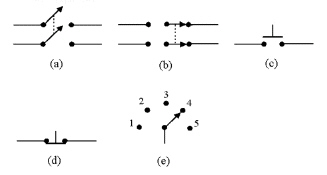
Figure 2-1
a. | graph
(a) | b. | graph (b) | c. | graph (c) | d. | graph (d) | e. | graph (e) |
|
|
|
25.
|
Identify the
Rotary switch in Figure
2-1.
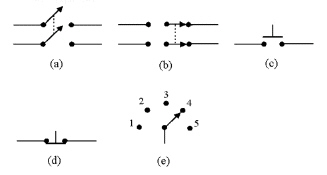
Figure 2-1
a. | graph
(a) | b. | graph (b) | c. | graph (c) | d. | graph (d) | e. | graph (e) |
|
|
|
26.
|
Which switch in Figure 2-1
could be used to simultaneously open or simultaneously close two circuits?
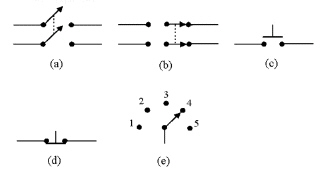
Figure 2-1
a. | graph
(a) | b. | graph (b) | c. | graph (c) | d. | graph (d) | e. | graph (e) |
|
|
|
27.
|
Identify the
Normally Closed Push Button
switch in Figure 2-1.
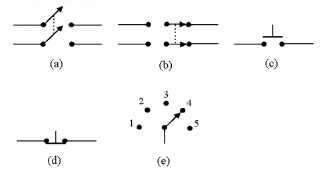
Figure
2-1
a. | graph
(a) | b. | graph (b) | c. | graph (c) | d. | graph (d) | e. | graph (e) |
|
|
|
28.
|
Which switch in Figure 2-1 is
usually used to control a doorbell?
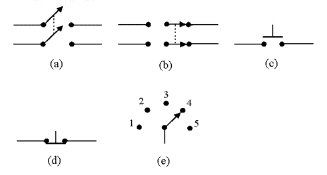
Figure
2-1
a. | graph
(a) | b. | graph (b) | c. | graph (c) | d. | graph (d) | e. | graph (e) |
|
|
|
29.
|
The Rotary switch in Figure 2-1 is most likely to be
used as ________.
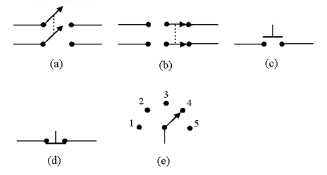
Figure
2-1
a. | a range selector switch in an analog
voltmeter. | b. | a selector for different voltages in a power
supply. | c. | an old manual TV channel selector. | d. | all of the
above |
|
|
|
30.
|
Identify the
DPDT switch in Figure
2-1.

Figure 2-1
a. | graph
(a) | b. | graph (b) | c. | graph (c) | d. | graph (d) | e. | graph (e) |
|
|
|
31.
|
Which switch in Figure 2-1
would probably be used to control a light and a fan at the same time?
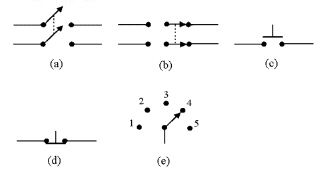
Figure 2-1
a. | graph
(a) | b. | graph (b) | c. | graph (c) | d. | graph (d) | e. | graph (e) |
|
|
|
32.
|
Which switch in Figure 2-1
could be used to switch two inputs to different output positions?
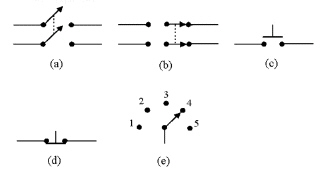
Figure 2-1
a. | graph
(a) | b. | graph (b) | c. | graph (c) | d. | graph (d) | e. | graph (e) |
|
|
|
33.
|
Which switch in Figure 2-1
could be used to open a circuit momentarily?

Figure
2-1
a. | graph
(a) | b. | graph (b) | c. | graph (c) | d. | graph (d) | e. | graph (e) |
|
|
|
34.
|
What do you call a diagram that
shows the electrical connections of a circuit's components?
a. | an electrical
diagram | c. | a pictorial
diagram | b. | a block diagram | d. | a schematic diagram |
|
|
|
35.
|
To measure a circuit's
source voltage, the voltmeter must ________.
a. | be placed across the
source | b. | have the red lead towards the negative side of the
source | c. | have the black lead towards the positive side of the
source | d. | be placed in series in the
circuit |
|
|
|
36.
|
A source, a path, and a load
________.
a. | will allow current to flow if the
switch is open | b. | make up a basic circuit | c. | can only be an open
circuit | d. | do not make up a complete
circuit |
|
|
|
37.
|
Voltage is
________.
a. | the force that exists between
charged particles | b. | the opposition to the flow of current | c. | the force that causes water to
flow | d. | the movement of free electrons |
|
|
|
38.
|
Which unit of charge contains
6.25 × 1018 electrons?
a. | a
coulomb | c. | an
ampere | b. | a volt | d. | a
joule |
|
|
|
39.
|
A conductor is a material that
has ________.
a. | few free
electrons | c. | a structure
similar to semiconductors | b. | many free electrons | d. | a positive charge |
|
|
|
40.
|
If a resistor equals 1.2 Ù ±5%, its color
code is ________.
a. | brown, black, red,
gold | c. | brown, red, gold,
gold | b. | brown, black, gold, silver | d. | brown, red, silver, gold |
|
|
|
41.
|
Every electrical circuit must
contain ________.
a. | a source, a load and a
resistor | c. | a battery, a
resistor and a capacitor | b. | a source, a load and a path | d. | a battery, a path and a switch |
|
|
|
42.
|
In order to measure the current
in a circuit, an ammeter must ________.
a. | be placed across the
source | b. | be placed across the load | c. | be placed so the current must pass through the
meter | d. | all of these |
|
|
|
43.
|
A resistor with yellow, violet,
orange and silver bands equals ________.
a. | 4.7 kÙ ± 10% | c. | 47 MÙ ± 10% | b. | 47 kÙ ±
5% | d. | 47 kÙ ± 10% |
|
|
|
44.
|
A resistor with yellow, violet,
orange, and gold bands equals ________.
a. | 47 kÙ ± 5% | c. | 47 kÙ ± 10% | b. | 4.7 kÙ ± 10% | d. | 47 MÙ ±
10% |
|
|
|
45.
|
If a resistor is color coded
with orange, orange, orange and silver bands, the resistance equals ________, the lower tolerance
limit equals ________ and the upper tolerance limit equals ________.
a. | 33 kÙ, 29,700 Ù, 36,300
Ù | c. | 33 kÙ, 31,350 Ù, 34,650
Ù | b. | 33 kÙ, 32,670 Ù, 33,330
Ù | d. | 33 kÙ, 26,400 Ù, 39,600
Ù |
|
|
|
46.
|
A 100 kÙ ±10% resistor is color coded
________.
a. | black, brown, yellow,
silver | c. | brown, black, yellow,
silver | b. | brown, green, black, gold | d. | brown, black, yellow, gold |
|
|
|
47.
|
In Figure 2-2, if you place a
voltmeter's red lead on point E and its black lead on point H, you will be measuring
________.
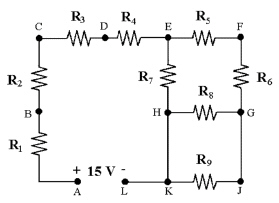
Figure 2-2
|
|
|
48.
|
To measure the current that
flows through R6 in Figure 2-2, the circuit must be opened and the ammeter placed at point
________.

Figure 2-2
|
|
|
49.
|
In Figure 2-2, the voltage VGH
is the same as ________.
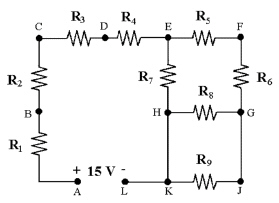
Figure
2-2
|
|
|
50.
|
In Figure 2-2, the voltage VFG
is the same as ________.
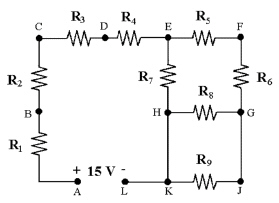
Figure
2-2
|
|
|
51.
|
In Figure 2-2, a voltmeter
placed across points C and D will measure ________.
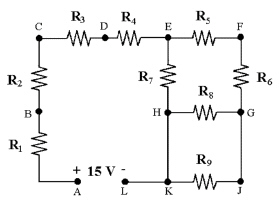
Figure 2-2
|
|
|
52.
|
In Figure 2-2, the voltage VCE
is the same as ________.
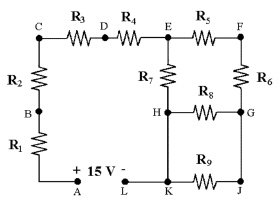
Figure
2-2
a. | VR6 | c. | VR5 | b. | VR4 + VR5 | d. | VR3 + VR4 |
|
|
|
53.
|
An analog meter has
________.
a. | a digital
readout | c. | a needle and a
scale to indicate the value | b. | a high degree of accuracy | d. | no moving parts |
|
|
|
54.
|
An ohmmeter should
________.
a. | be placed across the resistor after
the resistor has been disconnected from the circuit | b. | be inserted into the circuit so the current flows through
it | c. | be connected across a circuit with
the power on | d. | have the polarity carefully checked before its
use |
|
|
|
55.
|
Most DMMs will measure ________
________ and ________.
a. | voltage, current,
capacitance | c. | voltage,
frequency, resistance | b. | voltage, current, resistance | d. | frequency, voltage, current |
|
|
|
56.
|
On a resistor with five bands
of color code, the fifth band may represent that:
a. | the tolerance in percentage of
value. | c. | the reliability in percentage of
failure. | b. | the resistor is a precision resistor. | d. | all of these. |
|
|
|
57.
|
On a resistor with four bands
of color code, the fourth band represents:
a. | the voltage
rating. | c. | the wattage
rating. | b. | the tolerance percentage. | d. | the multiplier value. |
|
|
|
58.
|
On a resistor with numbers and
letters, the position of the letter in the sequence represents:
a. | the resistance
value. | c. | the numerical
total. | b. | the decimal point. | d. | the tolerance. |
|
|
|
59.
|
Interpret the following mixed
numbers and letters 4R7 on a resistor to the correct resistance of:
a. | 4.7
Kilohms. | c. | 47
ohms. | b. | 4.7 Megohms. | d. | 4.7 ohms. |
|
|
|
60.
|
Interpret the following mixed
numbers and letters 3M3 on a resistor to the correct resistance of:
a. | 33
Kilohms. | c. | 330
Kilohms. | b. | 3300 Kilohms. | d. | 3.3 Kilohms. |
|
|
|
61.
|
Potentiometers and rheostats
differ in that:
a. | potentiometers utilize linear and
nonlinear tapers, while rheostats usually utilize only linear
tapers. | b. | potentiometers utilize three terminals, while rheostats usually use only two
terminals. | c. | potentiometers are used to vary voltages, while rheostats vary
currents. | d. | all of these. |
|
|
|
62.
|
A common type of resistors
are:
a. | metal
film. | c. | carbon-composition. | b. | carbon film. | d. | wirewound. |
|
|
|
63.
|
In the American Wire Gauge
sizes, as the numerical value of AWG goes higher, the cross sectional area of the
wire:
a. | increases. | c. | decreases. | b. | doubles. | d. | halves. |
|
|
|
64.
|
The basic difference between a
fuse and a circuit breaker is that:
a. | a circuit breaker is more
reliable. | c. | a fuse is
faster. | b. | a circuit breaker is reusable. | d. | a fuse is reusable. |
|
|
|
65.
|
Which type of resistor is used
for high power applications?
a. | carbon
composition | c. | surface
mount | b. | film | d. | wire
wound |
|
|
|
66.
|
What does the schematic symbol
(b) represent in Figure 2-3?

Figure
2-3
a. | potentiometer | c. | thermistor | b. | rheostat | d. | photoconductive cell |
|
|
|
67.
|
Which of the following is not a
type of variable resistor?
a. | potentiometer | c. | photoconductive cell | b. | thermistor | d. | All are types of variable
resistors. |
|
|
|
68.
|
The voltage measured directly
across an open switch in a circuit will be:
a. | 0 V. | c. | full applied voltage. | b. | half of applied voltage. | d. | unpredictable. |
|